How to Develop an eCommerce App: Full-Spectrum Analysis
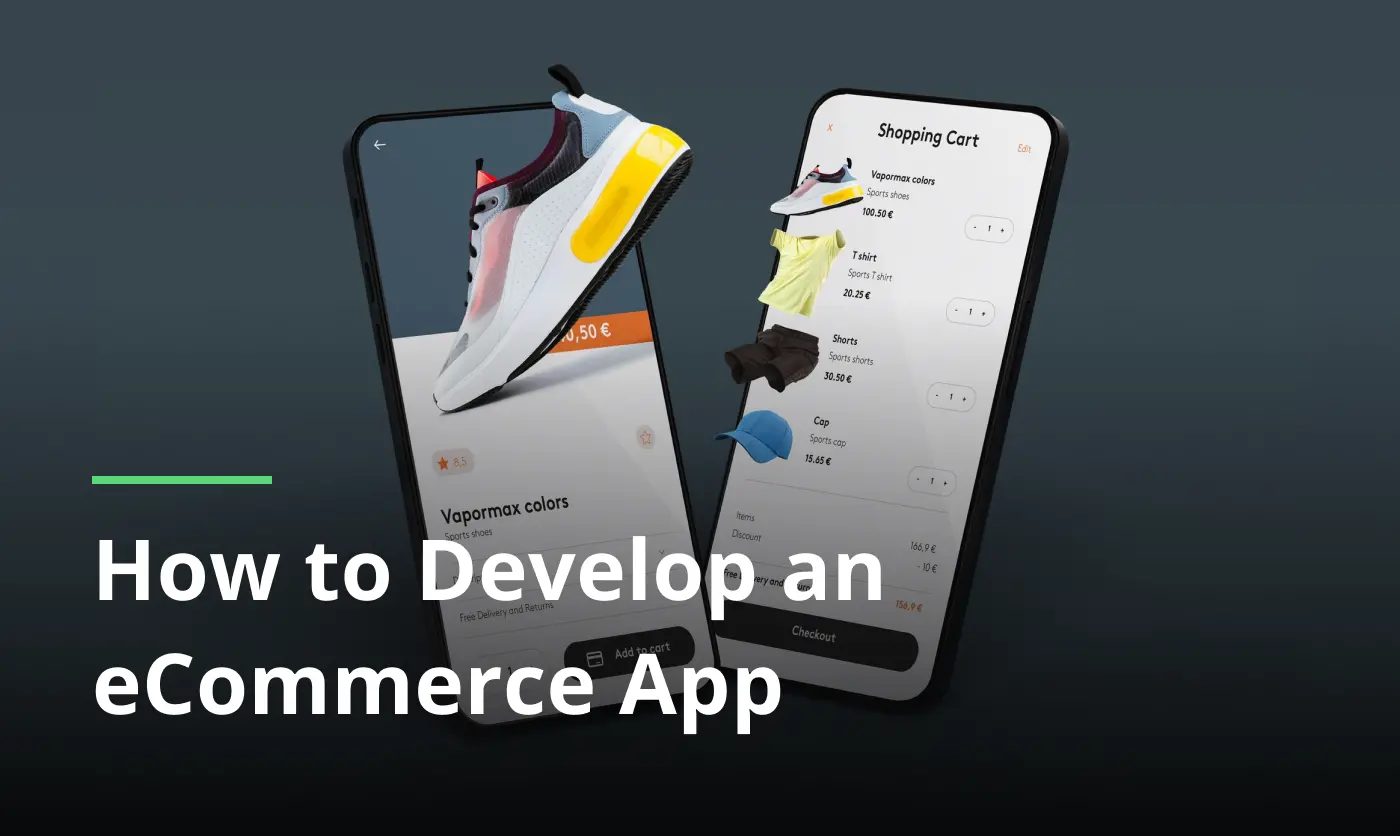
In 2026, eCommerce app development has taken center stage in the success of online shopping ventures. This review investigates the complete process of creating eCommerce apps by demonstrating successful methods, prevention strategies for failure and features boosting application success.
A well-executed plan to create an eCommerce app starts with choosing a company that understands both technology and user behavior. Every decision, from platform selection to payment integration and design, calls the shots for the final product. Behind every successful app is a well-coordinated team that balances business smarts with user-first design.
As mobile app development for eCommerce is on an upward trajectory, companies are drawing inspiration from giants like Amazon. To stay ahead, your solution must offer speed, security, and personalization and in this synopsis we will share our knowledge gained after 10+ years in the retail industry with our battle-tested veterans from Limeup.
What is an eCommerce app?
Learning how to create an eCommerce app is the primary objective for which you have come here. To begin we need to grasp the concept of this application type. A mobile utility named eCommerce offers direct sales of goods and services to their clients through smartphone and tablet use.
Everybody holds 60% of future retail purchasing power through mobile commerce in 2024 which strengthens the belief that retail’s future exists within handheld devices.
Three notable companies including abovementioned Amazon, eBay, Shopify crafted the first mobile shopping interface that provides smooth transactions to customers. Such platforms support features that offer individualized recommendations, fast checkout options and protected payment features to create smooth shopping processes.
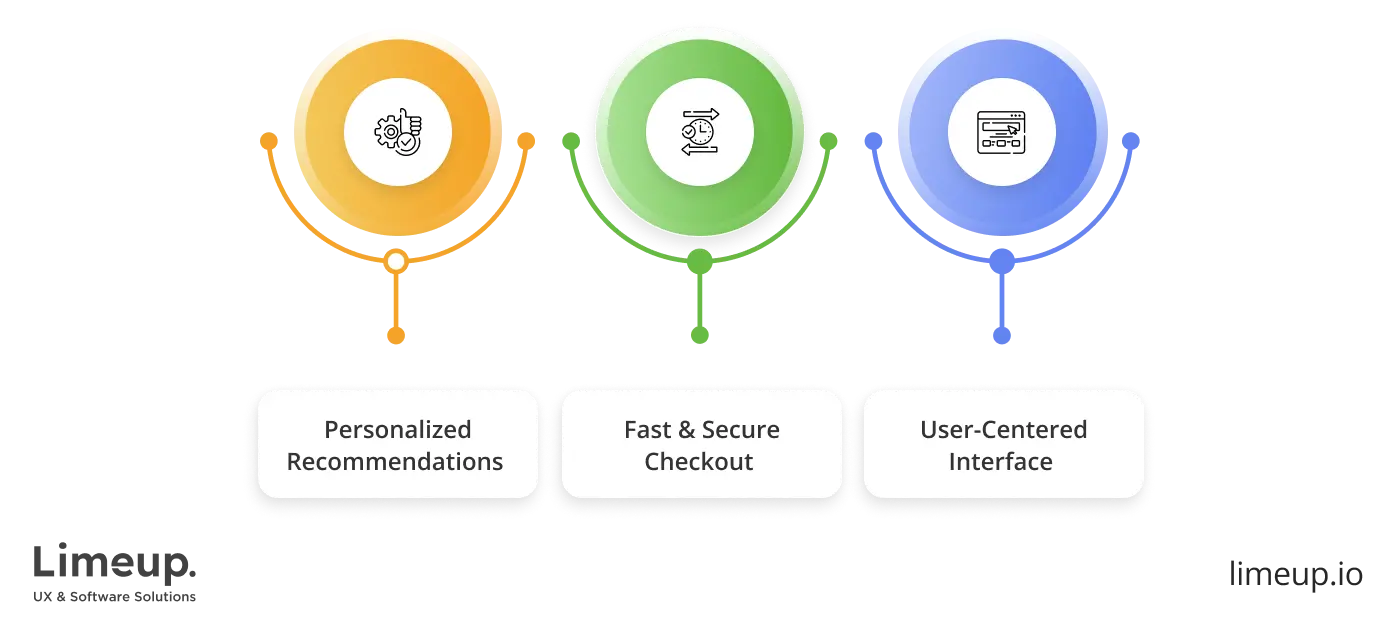
The road to effective eCommerce mobile app development is paved with user-centric design and advanced functionality. Top-tier digital tool requires more than friendly usability since it demands payment security, inventory control, uninterrupted interaction security.
App development companies in the UK and in other corners of the world assist their clients by guiding them through the sophisticated process of sculpting unique software in competition with numerous market players.
The projected mobile commerce expansion to $3.5 trillion in revenue by 2028 requires organizations to stay ahead in the competitive market. The creation of a reliable online sales platform has become critical because it symbolizes the need to maintain competitiveness through exceptional retail interaction delivery.
How to build commerce applications: 5 pillars of success?
The global retail market will widen to more than $7.9 trillion by 2027 due to mobile shopping providing an important segment of this acceleration. The rising market competition forces businesses to abandon their old technical platforms and complicated user interfaces. A highly effective commercial application demands integration of strategic direction, technological implementation, customization designed for users.
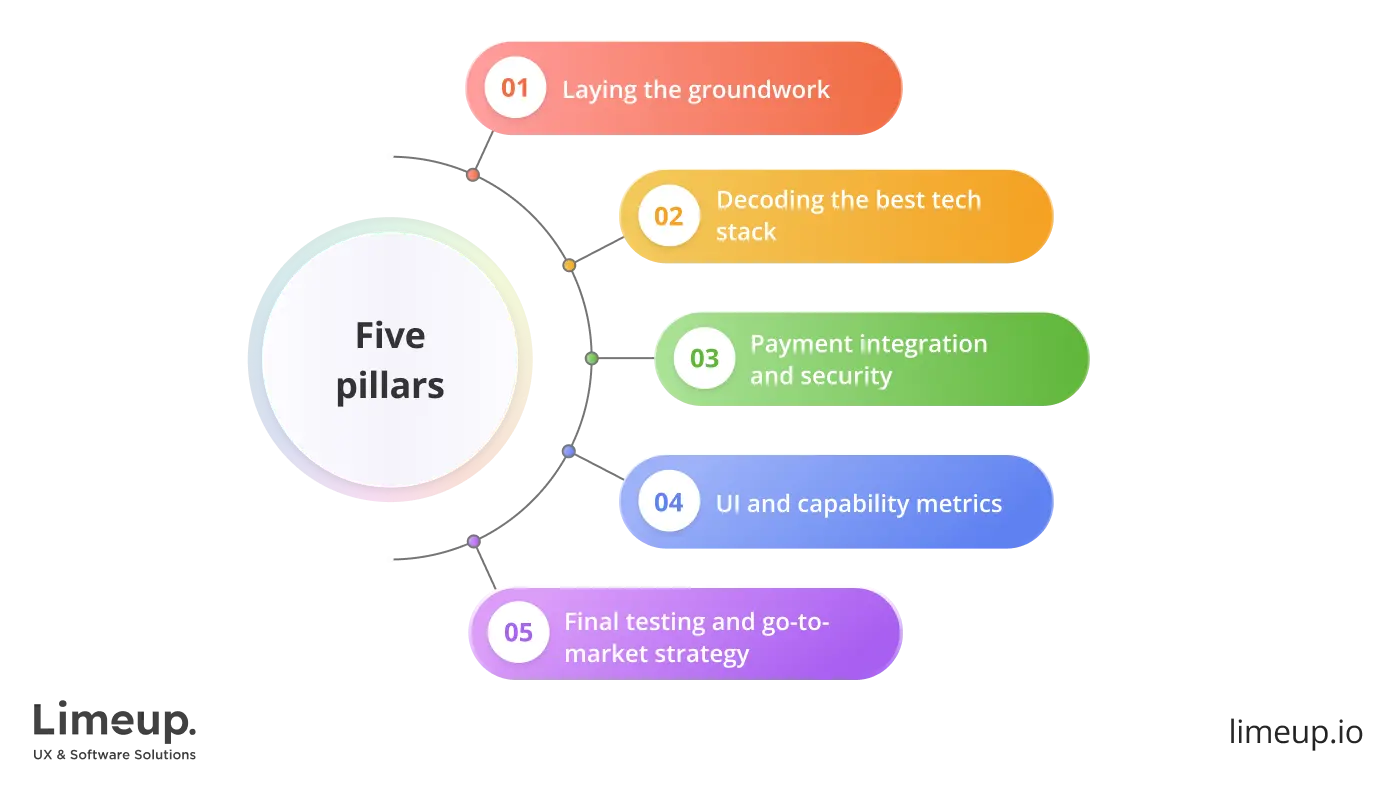
- Laying the groundwork
Every commerce application turning out successful begins by defining precise goals followed by thorough research. Market analysis centered on customer activities and industry patterns and sector needs enables companies to produce unique and effective products.
Forward-thinking firms opt for custom application development to create platforms that scale effortlessly, handling increased traffic and transactions without missing a beat.
As example, Shopify delivers infrastructure refines constantly to help its 4.7 million online platforms carry growing foundations successfully.
- Decoding the best tech stack
A commerce portal needs its technology stack to form its base architecture. Select native hybrid or web app development for eCommerce depending on how your audience connects with business and what financial resources are available. The advantage of native applications is exceptional performance yet they need distinct production work for both iOS and Android platforms.
To achieve cost reduction with functional persistence we advise to implement hybrid frameworks that include Flutter or React Native. F.e. Amazon combines native solutions and cloud-based infrastructure which provides users with uninterrupted throughput on diverse hardware platforms.
- Payment integration and security
A commerce application must have a secure payment system to ensure its total strength. The payment channels customers expect in their shopping path include swift and protected credit card options as well as digital wallet services such as Apple Pay and Google Pay
By 2028, the number of digital wallets is forecasted to expand from 564 million to 969 million, encompassing diverse regions and reshaping how payments are made worldwide.
Users protection against fraud through encryption in addition to PCI DSS compliance to establish trust.
- UI and capability metrics
Users stay invested when the system is fast and easy to interact with. Studies show that visitors to mobile sites tend to abandon them if the page takes more than three seconds to load. Adjusted internet stores offer lightning-fast load speeds, straightforward navigation and an interface designed with ease of use in mind.
Equipped with bespoke recommendations, voice-powered search, and effortless one-click checkout, Alibaba’s state-of-the-art AI shopping platform captures essential data on consumer actions, enhancing the effectiveness of conversion strategies.
- Final testing and go-to-market strategy
Every virtual marketplace application faces surprising operational difficulties despite its initial planning. Detailed testing in areas like functionality , security, usability ensures a trouble-free rollout. Engineering company conducts beta testing to collect real-life feedback from users right before the system goes live.
Case in point, eCommerce app development solutions by Walmart utilized thorough A/B testing that led to a transformation of its interface leading to record-breaking 98% gain in mobile orders.
Creating a virtual store requires more than coding because it has to establish UX which drives customer retention. A business is capable of creating standout mobile applications by having proper strategy, technological decisions and user-centric approaches for the marketplace.
What are the key features of eCommerce app development?
To achieve success in virtual retail platform design one must strike an exact equilibrium between visual elements and capabilities combined with user interaction standards. The extent of mobile shopping demands that your app combines trouble-free interaction with shielding mechanisms to uphold operational flow.
Warning: exif_imagetype(https://limeup.io/wp-content/uploads/2025/03/key-features-of-eСommerce-app-development.webp): Failed to open stream: HTTP request failed! HTTP/1.1 400 Bad Request in /home/limeup/limeup.io/www/wp-includes/functions.php on line 3343
Warning: file_get_contents(https://limeup.io/wp-content/uploads/2025/03/key-features-of-eСommerce-app-development.webp): Failed to open stream: HTTP request failed! HTTP/1.1 400 Bad Request in /home/limeup/limeup.io/www/wp-includes/functions.php on line 3363
Warning: Trying to access array offset on value of type bool in /home/limeup/limeup.io/www/wp-content/themes/limeup-agency/template-parts/blog/single-blog-final-constructor-content.php on line 1228
Warning: Trying to access array offset on value of type bool in /home/limeup/limeup.io/www/wp-content/themes/limeup-agency/template-parts/blog/single-blog-final-constructor-content.php on line 1229
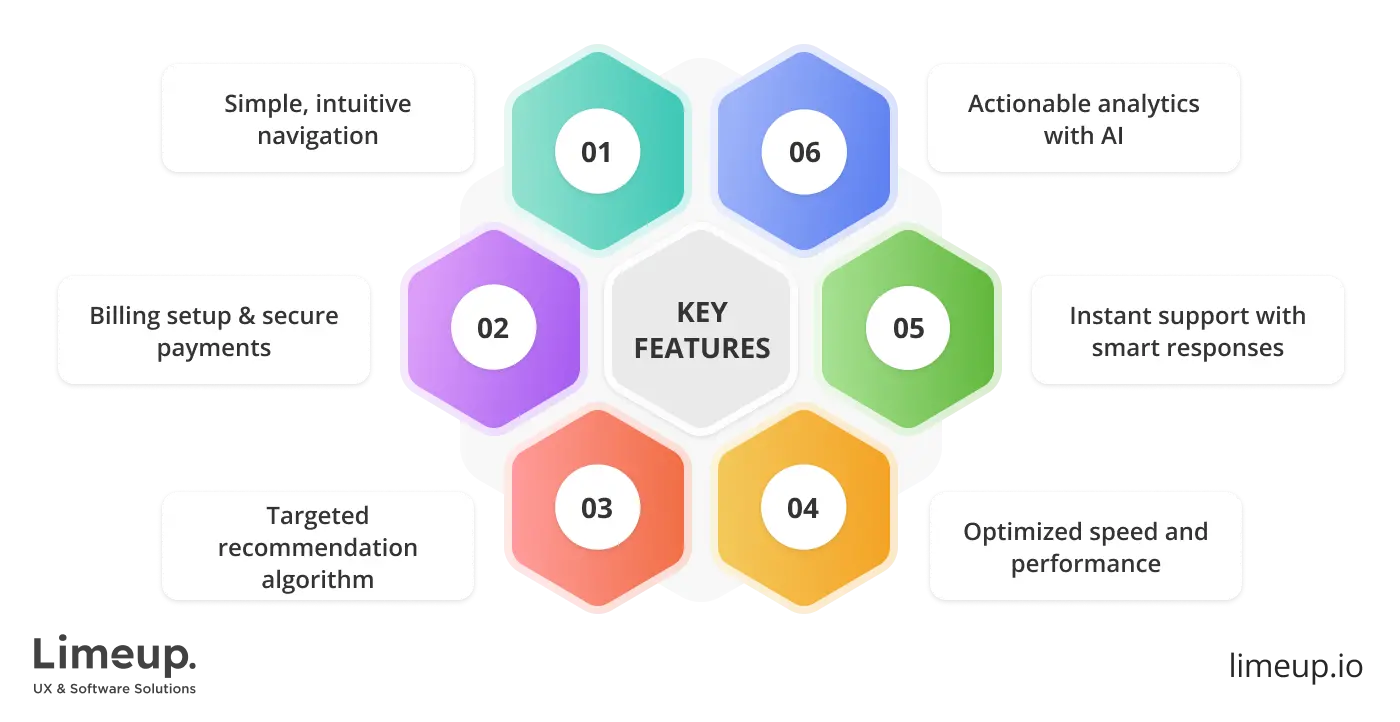
Clear and easy-to-follow navigation paths. Product engineered by eCommerce app developer has to entail intuitive UI that leads users through product checkouts and shopping cart procedures until purchase is complete. Your venture becomes more appealing to buyers with each step your process simplifies. The straightforward nature of design creates process which new customers are able to understand and complete effortlessly.
A layout which feels natural to users contributes to reduced purchase process difficulties by offering user-friendly navigation points. The combination of feature integration including filtered search tools and wish list functionality and quick route to the shopping cart increases overall conversion rates. Hire mobile app designers with wealth of acumen like Limeup to shape an intuitive and aesthetically refined app.
Billing configurations and secure transactions. We are repeating but in creation of online shop a defended system that guarantees payment gateway protection is a must. Users have to stay with assurance that their data and their financial information will remain safe.
Be sure to hire an eCommerce mobile app development company that builds multiple defense strategies with SSL encryption, biometric logins, multi-factor authentication to safeguard valuable information.
Different payment methods increase the chances of completing sales. Mobile wallets, credit cards, cryptocurrency alternatives are on the rise as payment methods in eRetail platforms. The growing popularity of mobile payout systems required to integrate Apple Pay, Google Pay, PayPal to retain customers who prefer mobile transactions.
Targeted recommendation algorithm. The industry achieved revolutionary change through modification. The purchasing history combined with preferences as well as behavior patterns of customers drives their desire for customized shopping exposure. Unique experience generation by offering curated content and special discounts fosters client loyalty which drives sales upward.
Companies with exclusive treatment achieve conversion rate increases up to 25% (as McKinsey points out). Content suggestions on Netflix get users to remain engaged and Amazon-type websites utilize equal approaches to deliver product recommendations to their customers.
Through user data analysis and algorithm implementation your company becomes able to transform the shopping path for each individual which drives them to return both shopping and purchasing.
Turbocharged performance and load time optimization. The main characteristic of shopping through mobile devices is the speed at which consumers are able to browse and purchase items. Google demonstrates that 53% of online visitors will leave websites which take more than 3 seconds to fully load.
eCommerce Android app development demands immediate attention to both speed of page loading and UX fluidity since these factors determine user retention. Your endeavor must be sharpened for mobile platform to achieve prime execution across different devices with distinct sizes.
Users using both iPhone and Android should encounter the same harmonious flow in your application. Your product response time may be improved through several measures including image adjustment codes and problems reduction as well as the implementation of adaptive design.
Live support and smart response channels. After purchase completion a successful mobile shopping interface extends its operations through high-quality customer support channels. A live chat system, helpful FAQs, comprehensive customer support maintain users and enhance their impressions. Several forms of in-app communication such as chatbots, messaging features offer quick solutions to customer challenges and email assistance.
Actionable data and AI-powered insights. Numbers tell the story of success. From sales reports to customer heatmaps, analytics reveal trends that might otherwise go unnoticed. Understanding drop-off points and high-engagement areas enables brands to eliminate obstacles, tweak promotions, fine-tune the journey from discovery to checkout.
Tech Stack for mobile app development for eCommerce
High-conversion sales platform requires selection of proper technology toolkit. Performance, its ability to expand and adapt meets its future requirements through this selection. Enterprises which base their engineering tool and framework choices on knowledge gain lasting success.
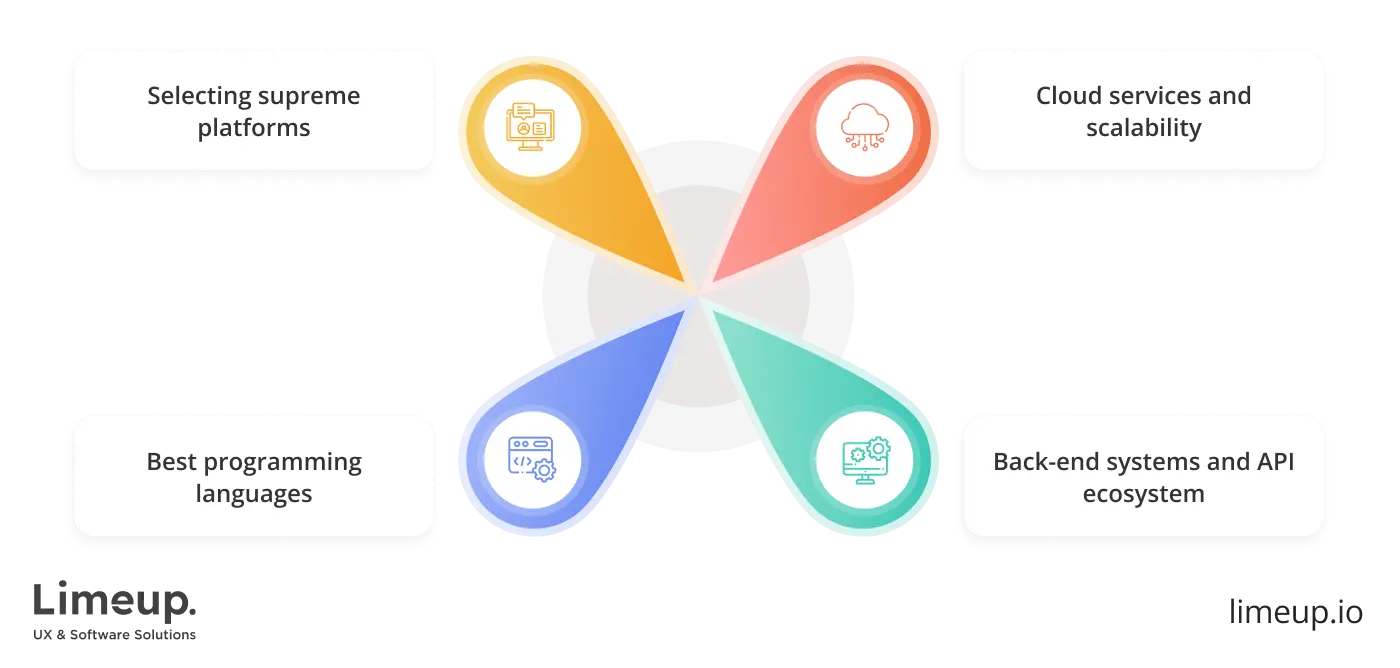
- Selecting supreme platforms
As a primary step mobile app makers must decide if they want to produce native applications or choose hybrid or web-based ones. When coders create separate native versions of their apps for iOS and Android their solutions achieve peak performance and complete system functionality access. The native mobile eCommerce app development approach enables consistent performance across all its devices.
Programmers who use hybrid frameworks such as Flutter and React Native may create applications for different platforms using a single shared codebase thus shortening production time and reducing expenses. Progressive Web Applications (PWAs) offered by Starbucks through web browsers deliver application-quality interaction with minimal storage requirements of the device.
- Best programming languages and frameworks
Swift and Kotlin dominate native programming, showing reliability and efficiency. Lyft transitioned to Swift, leading to improved stability and performance, while Pinterest saw a 15% reduction in crashes after switching to Kotlin for its Android ecosystem.
React Native, used by Instagram, enables seamless cross-platform functionality.
Bloomberg used eCommerce app development services to build its mobile portal with React Native, achieving a smooth and unified processing across iOS and Android.
Flutter, chosen by eBay Motors, allows for high-performance UI rendering and rapid generation. BMW incorporated Flutter into their car control app, achieving a sleek and responsive interface that ensures smooth animations and seamless user interactions across all devices.
- Back-end systems and API ecosystem
The functioning of a digital purchasing tool requires a strong system for inventory and payment management together with user data handling. A common practice in server-side eCommerce web app development finds Node.js, Python using Django, Ruby on Rails as prevailing options.
Leading retailers use RESTful or GraphQL APIs because these technologies create efficient interfaces between user interfaces and servers for speedy response time delivery. The online marketplace eBay made use of GraphQL to restructure its APIs thus enhancing UX while reducing overall response duration.
- Cloud services and scalability
User traffic volatility may be dealt with ease through cloud solutions from AWS and Google Cloud and Microsoft Azure. During Black Friday sales Shopify delivers service to millions of stores with the help of Google Cloud infrastructure. Online stores under scalable architecture perform optimally irrespective of peak and non-peak shopping periods.
So why should you hire app developers who are proficient in your sector?
A properly selected technical stack depends on the quality of execution by the implementation team. Pursuing businesses aiming to own intuitive high-performing web-based marketplace must select mobile app designers proficient in contemporary frameworks.
A well-composed design team maintains perfect alignment between chosen technologies and the Ui/UX in order to deliver a slick shopping adventure.
How long does it take to create an eCommerce app?
An online shop does not appear in a short period of time. Bringing it to life requires orchestrated planning, technical dexterity and relentless debugging to maintain efficiency.
The duration depends on several aspects such as app complexity, features and selected implementation approach. It typically takes 6 months to one year to develop an eCommerce app which offers multiple features while startups might complete MVP creation within a few months.
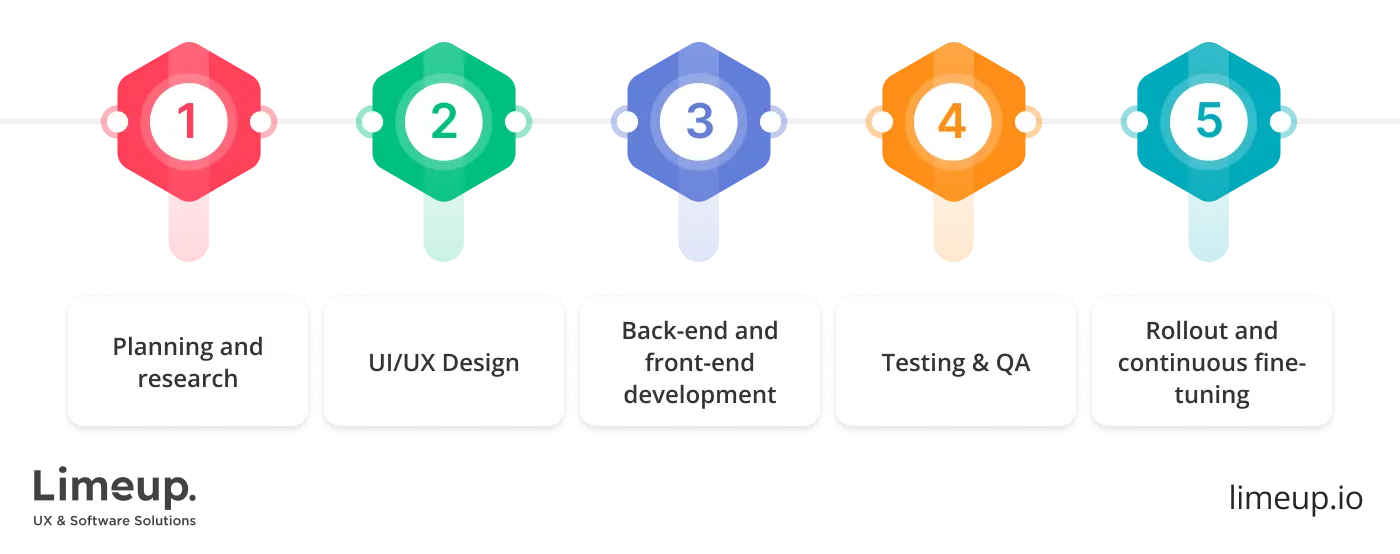
— Planning and research (2-4 weeks)
A business must specify their aims, customer base, and essential characteristics before team members begin coding. Analyzing the marketplace enables companies to establish exclusive value propositions for their customers. Successful planning at this point minimizes expensive problems that might emerge in future custom eCommerce app development stages.
— UI/UX Design (4-8 weeks)
Application success depends on intuitive design, which involves the creation of wireframes, prototypes, and user flows to simplify site traversal. ASOS stands out since mobile shopping drives its operations, so it works on amplifying user interfaces to maintain high engagement levels.
— Back-end and front-end development (12-24 weeks)
The core infrastructure shaping happens during this phase while APIs are integrated to make the server interact with the user interface. Additional time will be taken by eCommerce application developers to include features like AI recommendations and AR shopping if the app includes them.
As an illustration, Amazon dedicates significant resources toward machine learning advancements for customized shopping, although this powerful breakthrough requires extensive deployment time.
— Testing and quality assurance (4-8 weeks)
Testing protocols detect all security weaknesses and any functionality issues that could affect the responsiveness of the application. One single bug has the ability to disrupt sales because customers convert less frequently when page loading delays reach one second. Walmart conducts comprehensive testing of new app versions to ensure their operation remains stable during times of heavy usage.
— Rollout and continuous fine-tuning
Android eCommerce app development is not the finish line. Programs prosper through continuous monitoring, user feedback analysis, and performance enhancements. The mobile system of eBay constantly undergoes modifications that contribute to faster processing and increased user protection while maintaining customer interest.
You may be wondering “What has an impact on development duration?” and we have some suggestions for you:
| Factor | Impact on production time | Example |
| Technical depth | Advanced features like AI, AR, and individual recommendations require additional time. | IKEA’s AR-powered IKEA Place took months to ensure accurate 3D furniture placement. |
| Third-party compatibility | Payment gateways, CRM tools, and inventory systems must be seamlessly connected. | Etsy integrates multiple payment providers, requiring careful API handling. |
| Team size and domain knowledge | A proficient and well-coordinated tech group accelerates progress. | Netflix’s powerhouse of developers keeps the platform in a constant state of evolution. |
| Construction methodology | Agile approach in eCommerce mobile app development services enables faster iterations and feature rollouts. | Zalando uses Agile sprints to release frequent updates. |
| Pre-built vs. custom solutions | Ready-made platforms shorten timelines, while custom builds take longer but offer flexibility. | Nike’s SNKRS was built from scratch to support limited edition drops, delaying launch but leaving space for growth. |
The process of transforming a concept into a thriving eCommerce product is a marathon, not a sprint. Success lies in the hands of those who combine vision, strategy and a skilled team to form an app that stands tall in the crowded digital marketplace.
How much does eCommerce application development cost?
Implementing an digital purchasing tool demands significant financial resources which depend on the number and kinds of features and the country where the team operates. The price range is between $30,000 for basic functions and $300,000 for high-end applications with AI personalization and augmented reality features. Limeup’s team has scrutinized the market and distilled main budget determinants:

Feature-richness and app intricacies
Minimal mobile retail space that feature product displays coupled with shopping carts and payment processing functions maintain affordability whereas sophisticated platforms containing AI-based recommendation and inventory tracking must be more pricey.
Organizations budget at least $50,000 (plus additional expenses) for implementing augmented reality (AR) features in their virtual product preview formation.
Platform choice
The selection between Android or eCommerce iOS app development or building for both platforms affects the outlays. An application built using native platforms demands higher costs than hybrid solutions built on React Native or Flutter. The fee reduction achieved by startup organizations comes from cross-platform creation tools proven by Airbnb with its React Native implementation for system unification.
Offshore vs. onshore programming squad
North American engineers charge a minimum of $100 to $200 per hour as they possess sophisticated skills and work in areas where spending remains elevated. Eastern European eCommerce app developers provide cost-effective solution for projects because their hourly rates fall between $40 to $80. In Ukraine you can find highly affordable alternatives by charging between $20 and $50 per hour even though the deliverables maintain equivalent high quality.
External platform connections
As we know, operations become more expensive when integrating payment gateways, analytics tools and shipping APIs. To create an eCommerce app, expect to spend from $3,000 and $5,000 when it includes both Stripe and PayPal payments while Google Analytics 360 demands an annual fee surpassing $150,000. Each necessary investment brings substantial financial weights to the total budget expenditure.
Protection and legal conformance
Financial outgo required to meet PCI DSS standards for secure payment processing usually fall between $10,000 and $50,000. Whole-scale protection of consumption data requires advanced data encryption, fraud detection systems and GDPR adherence which results in added disbursements yet sustains consumer security as well as transaction safety.
In summary of this chapter we may conclude that everything hinges on your vision. A simple app might fit a modest budget, but if you’re looking to go toe-to-toe with industry titans, prepare for a price to match your ambition. One thing is clear: skimping on quality now will lead to a much heftier price down the road.
How to select an eCommerce app development company?
Identifying an appropriate one amidst eCommerce app development companies poses challenges since numerous companies exist in the market.
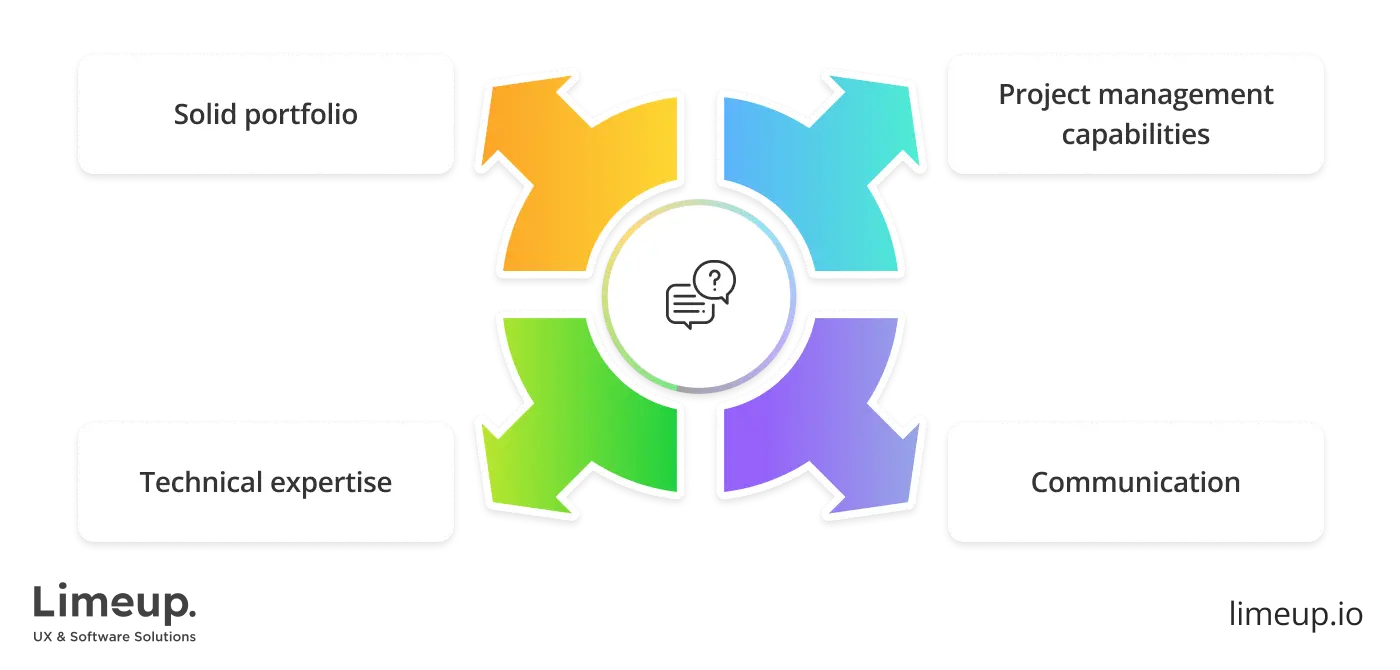
Your search must begin with businesses that demonstrate acumen in creating online shop. A professional team building apps should possess deep knowledge about its production for diverse structures and industrial sectors. A solid portfolio demonstrates the company’s capability to develop user-friendly programs that deliver high performance and lead to conversions while improving customer experience.
Next, prioritize technical expertise. Industrial excellence for eCommerce app development depends on the company’s know-how in current market technologies and available frameworks. Check that tech group deals with mobile-first design, payment integration features and adaptation abilities.
For a truly lasting product you need skills related to communication with project management capabilities. Views from a reputable company about your project remain open throughout the eCommerce mobile application development period to achieve goal and timeline alignment. Agile methods serve as a reliable sign that companies may modify their projects according to changing specifications while maintaining project timetables.
Finally, don’t overlook post-launch support. Having your product deployed requires a dependable partner who will tackle update duties while taking care of maintenance along with troubleshooting needs. Your future allies must show their dedication to enlargement by keeping your app powerful and secure yet updated in the rapidly transforming marketplace.
Wrapping up
In the fast-paced world of retail, developing a winning app requires careful planning, the right technology and an understanding of user needs. Every aspect, from intuitive design to secure payment processing, contributes to the app’s ability to drive sales and create lasting customer loyalty. The decisions made during eCommerce applications development will impact not only the functionality but also its ability to scale and meet future demands.
At Limeup, we specialize in turning ambitious visions into groundbreaking realities. Our team of professionals is unwavering in its pursuit of developing virtual marketplace that deliver superior user experiences and empower your business to flourish, making waves in the digital marketplace.
If you aim to go beyond the basics and create a truly exceptional system, we’re here to help. Reach out to Limeup, get consultation from our savvy eCommerce mobile app developer and build a platform that stands out and delivers unmatched value.

